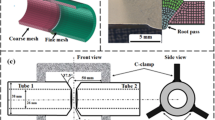Abstract
Welding is one of the most important joining technologies in modern process and power plant construction. At present, martensitic heat resistant 9–12% chromium steels are one of the favored materials used for high temperature components, because of their good weldability, excellent hot workability and high creep strength. Nevertheless, under service conditions, for a number of these martensitic steels, the fine grained or intercritical heat affected zone (HAZ3) has the poorest creep strength since the heat input of the welding affects the microstructure of this zone. Furthermore the stress situation and multiaxiality of the stress state in the weld region changes permanently due to creep and relaxation. Experimental results show a strong influence of the factor of multiaxiality of the stress state on the creep behaviour of components especially of welded components. This paper gives a phenomenological description of the specific damage and failure behaviour of creep loaded welds. The previously mentioned time dependent stress — strain situation in weldments will be discussed and the influence of the multiaxiality of the stress state will be identified. Basic possibilities to avoid premature failure in the HAZ region are shown such as the optimum heat treatment of the base metal (BM) prior to welding, the variation of the welding methods and the optimization of the welding geometry and the deposit materials.
Similar content being viewed by others
References
Mayr P “Evolution of microstructure and mechanical properties of the heat affected zone in B-containing 9% chromium steels”, Dissertation TU Graz, (2007)
Theofel H, Schemmel J and Klenk A, “Nachweis der Langzeiteigenschaften von Schweißverbindungen moderner Stähle für den Einsatz in Dampferzeugern im Bereich bis 620°C”, Final report of research project AVIF A 129, MPA Stuttgart, (2001)
Roos E, “Optimierung der Schweißverbindung zur Verhinderung des vorzeitigen Kriechversagens in der Wärmeeinflusszone über die gezielte Festigkeitsauswahl des Schweißgutes”, final report of research project AVIF 221 MISMATCH, to be published 08/2008.
Roos E, et al., IJMR, 99 (2008) 402.
Schubert J, Klenk A and Maile K “Determination of weld strength factors for the creep rupture strength of welded joints. International Conference on Creep and Fracture in High Temperature Components — Design and Life Assessment Issues”, European Creep Collaborative Committee (ECCC), IOM London, 12–14 September 2005.
Tabuchi M and Takahashi Y, “Evaluation of creep strength reduction factors for welded joints of modified 9Cr-1Mo steel (P91)”, 2006 ASME Pressure Vessels and Piping Division Conference, Vancouver, ASME, (2006).
Takahashi Y and Tabuchi M, “Evaluation of creep strength reduction factors for welded joints of HCM12A (P122)”, 2006 ASME Pressure Vessels and Piping Division Conference, Vancouver, ASME, (2006).
Hahn B, Baumhoff V and Zschau M, “Use of X10CrMoVNb9-1 Steel in Power Plant Retrofitting Applications — Experience and Application Potential, in Advanced Heat Resistant Steel for Power Generation” Viswanathan R and Nutting J (eds).Conference Proceedings. 27–29 April. 1998. San Sebastian. Spain
Bendick W, Haarmann K and Zschau M “E911 Ein neuer Werkstoff für Dampfleitungen im Kraftwerksbau”, VGB Kraftwerkstechnik 5/2000
Hald J, “Long-term Stability of 9- to 12% Cr Steels — Current Understanding and Future Perspectives”, VGB PowerTech 12/2004
Maile K, et al.: “Zeitstandverhalten von P91-Schweißverbindungen”, 19. Vortragsveranstaltung AGW/AGHT, Düsseldorf, 1996, Germany
Husemann R U et. al., “Langzeiteigenschaften von Schweißverbindungen moderner Stähle für Dampferzeuger”, 23. Vortragsveranstaltung AGW/AGHT, Düsseldorf, 2000, Germany
Maile K, et. al.: “Behaviour of similar welds in T24 Tubes and E911 pipes, 3rd HIDA and Integrity Conference, Integrity of High Temperature Repair Welds”, Oeiras-Lisabon, Portugal, 16–18 September, 2002, pp. 69/80
Clausmeyer H, Kußmaul K and Roos E, “Influence of Stress State on the failure behaviour of cracked components made of steel”, Appl. Mech. Rev., ASME, 44(2) (1991).
Maile K and Seliger P, “Kriterien zur Schädigungsbeurteilung von Hochtemperaturbauteilen aus martensitischen 9–11 % Cr-Stählen”, final report of research project AVIF 229 Schädigungsentwicklung 3, 2008.
Graham A and Walles K F A, Journal of The Iron and Steel Institute, 179 (1955) 104.
Maile K, et al.: “Qualifizierung von Werkstoffen zum Einsatz in Dampferzeugeranlagen mit erhöhten Temperaturen”, Wirtschaftsverband Stahlbau und Energietechnik e.V., Düsseldorf; 1999 VGB Kraftwerkstechnik No. 7/2000; pp. 86–88 and No. 8/2000; pp. 97–101
Maile K and Seliger P, “Characterisierung der Schädigungsentwicklung zur Lebensdauerbewertung von Rohrleitungskomponenten aus den neuen 9% Cr-Stählen”, final report of research project AVIF 152 Schädigungsentwicklung 2, 2004.
Cerjak H, “The role of welding in the power generation industry”, Houdremont lecture on the occasion of the 61st IIW annual assembly, Graz, (2008)
Author information
Authors and Affiliations
Corresponding author
Rights and permissions
About this article
Cite this article
Roos, E., Bauer, M., Klenk, A. et al. Description of failure modes in welded components operating in the creep regime. Trans Indian Inst Met 63, 101–109 (2010). https://doi.org/10.1007/s12666-010-0014-0
Received:
Revised:
Accepted:
Published:
Issue Date:
DOI: https://doi.org/10.1007/s12666-010-0014-0




